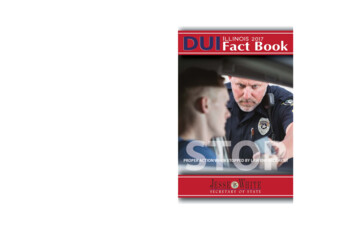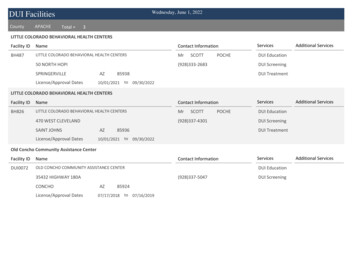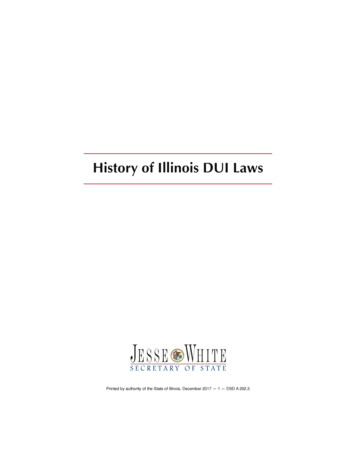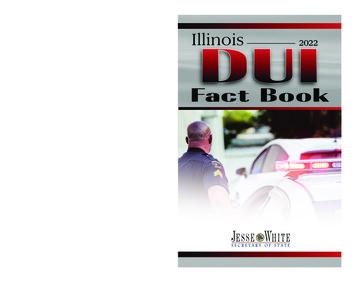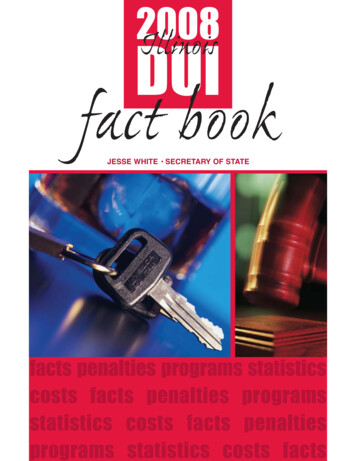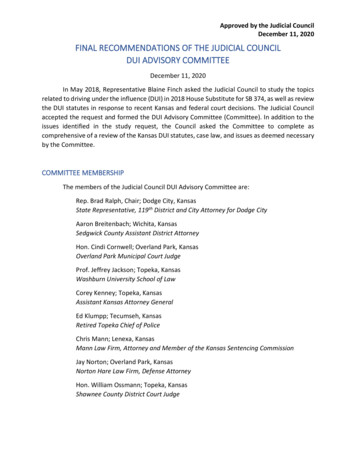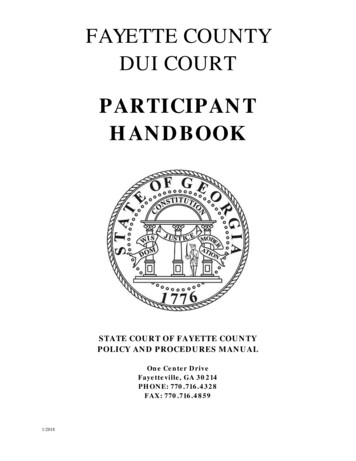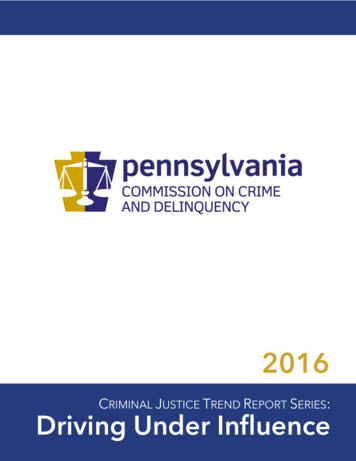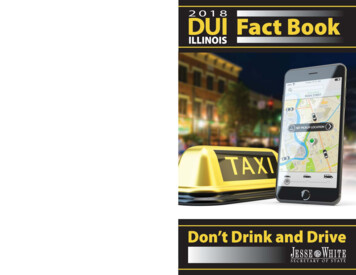
Transcription
DSD A 118.21 duifact.qxp Layout 1 1/16/18 1:17 PM Page 1A message fromSecretary of State Jesse White2018 DUIFact BookI am pleased to provide this 2018 Illinois DUIFact Book, which features factual informationabout Illinois’ efforts to combat drunk driving.Illinois’ roadways continue to be among thesafest in the nation due to our tough laws ondrunk and distracted driving. Our statecontinues to receive national recognition forits prevention efforts.My office offers free copies of our awardwinning DUI videos and public serviceannouncements, as well as traffic safetyspeakers and publications to educate peopleabout the consequences of drinking anddriving. To request a video, speaker orpublications, please call the Traffic SafetyHotline at 866-247-0213.I look forward to continuing our efforts towardmaking Illinois roadways safer.Jesse WhiteSecretary of State
DSD A 118.21 duifact.qxp Layout 1 1/16/18 1:17 PM Page 2The statistics presented in this 2018 Illinois DUI Fact Book arethe most recent numbers available at the time of publication.This manual does not cover every aspect of Illinois’ DUI lawsand should not be cited as a legal authority in court. Printed on recycled paper.Printed by authority of the State of Illinois. January 2018 — 5M — DSD A 118.21
DSD A 118.21 duifact.qxp Layout 1 1/16/18 1:17 PM Page 3Table of ContentsDriving Under the Influence (DUI) .6Blood-Alcohol Content (BAC).6Medical Cannabis (Marijuana) .7Chronology of a DUI Arrest .8Proper Action When Stopped by Law Enforcement.92016 Illinois DUI Facts.10New Laws Concerning DUI in Illinois .10Statutory Summary Suspension/Revocation.11Failing Chemical Testing.12Refusing to Submit to Chemical Testing .12Judicial Hearings.12Administrative Driver’s License Revocation.13Penalties for a DUI Conviction.13Aggravated DUI .15Reckless Homicide .16Additional Consequences of DUI.16Vehicle Impoundment.16Breath Alcohol Ignition Interlock Device (BAIID) .16Driving Permits.18Monitoring Device Driving Permit (MDDP) .18Restricted Driving Permit (RDP) .18Driver’s License Reinstatement .19Statutory Summary Suspension.19Revocation (Including Statutory Summary Revocation).19Case Dispositions.20Underage Drinking & Related Offenses .22Zero Tolerance .22Use of Fraudulent or Fake ID by a Person Under Age 21.23Parental Responsibility .23Purchase, Possession, Receipt or Consumption of Alcohol by a Minor.23Providing Alcohol to a Person Under Age 21.23Illegal Transportation of Alcohol.24Hotel/Motel Responsibility.24Other DUI-Related Offenses & Penalties .24Possession of Drugs in a Vehicle .24Knowingly Permitting a Driver Under the Influence to Operate a Vehicle.24Out-of-State DUI Conviction .24DUI Involving Motorboats or Snowmobiles .24Electronic Court Monitoring of Alcohol/Drugs.25Dram Shop.25 3
DSD A 118.21 duifact.qxp Layout 1 1/16/18 1:17 PM Page 4Illegal Transportation/Open Container .25Fraudulent IDs and Driver’s Licenses .26Driving on a Suspended or Revoked License .26Victims’ Rights.27Reporting of Injured Impaired Drivers .28Secretary of State DUI Programs .28ChartsIllegal BAC Limits in Illinois .52016 BAC Levels of Drivers Who Failed a Chemical Test .62016 Illinois DUI Arrest Rate .72016 Case Dispositions .20Average Cost of a DUI Conviction in Illinois.21Under 21 DUI Arrests & Zero Tolerance Violations.22Illegal Transportation Convictions.25DUI Penalty Chart.29Zero Tolerance Violations by County (2014-2016) .30Drivers Arrested for DUI by County (2014-2016).32 4
DSD A 118.21 duifact.qxp Layout 1 1/16/18 1:17 PM Page 5Illegal BAC Limits in IllinoisDrivers under age 21 . .00School bus drivers . .00Commercial driver’s license holders . .04Drivers age 21 and over . .08Number of drinks and BAC level in ONE HOUR of drinkingBAC.101 Drink4.08.06.0432 Drinks3224 Drinks1.023 Drinks.00Male — 170 poundsFemale — 137 pounds1 drink .54 ounces of pure alcohol*All contain an equivalent amount of alcohol{1 can of beer1 glass of wine1 shot of liquor* The amount of alcohol in a poured/mixed drink is dependenton the type of drink and the person who pours it. 5
DSD A 118.21 duifact.qxp Layout 1 1/16/18 1:17 PM Page 6Driving Under the Influence (DUI)“Driving Under the Influence” is defined as operating a motor vehicle while impairedby alcohol, other drugs, including cannabis (marijuana) prescribed for medicalpurposes, or intoxicating compounds and methamphetamine. In Illinois, driversare legally considered to be under the influence if they have a blood-alcohol content (BAC) of .08 or more, a tetrahydrocannabinol (cannabis) concentration (THC)of either 5 nanograms or more per milliliter of whole blood or 10 nanograms ormore per milliliter of other bodily substance, have used any other controlled substance or are impaired by medication.Blood-Alcohol Content (BAC)A driver’s BAC is based on the ratio of alcoholto blood or breath. However, an individual witha BAC between .05 and .08 may be convicted ofDUI if additional evidence shows the driver wasimpaired.The effect of alcohol on an individual is determined primarily by two factors: the amount of alcohol consumed and the rate at which it isabsorbed by the body. Other contributing factorsinclude gender, body weight, alcohol tolerance,mood, environment and the amount of food consumed.2016 BAC Levels of DriversWho Failed a Chemical Test.08-.097%.10-.1436%.25- 6%.20-.2415%.15-.1935%From the first drink, alcohol affects coordination and judgment. Even with a BACwell below .08, a person’s reaction time slows. The risk of being in a crash beginsto climb with a BAC between .04 and .05 and increases rapidly thereafter. By thetime drivers reach a BAC of .06, they are twice as likely to be involved in a fatalcrash as non-drinking drivers. By the time drivers reach a BAC of .08, they are 11times more likely to be killed in a single-vehicle crash than non-drinking drivers.The only way to rid the body of alcohol is time. Fresh air, coffee, a shower andfood cannot help a person become sober. It takes about one hour for the body toThe average DUI offender is: male (75 percent arrested are men); age 34 (57 percent are under age 35); arrested between 11 p.m. and 4 a.m. on a weekend; and caught driving with a BAC of .16 —twice the illegal limit.— Office of the Illinois Secretary of State 6
DSD A 118.21 duifact.qxp Layout 1 1/16/18 1:17 PM Page 7metabolize one drink. Each of the following has a comparable amount of alcoholand counts as one drink: one 12-ounce mug of beer, one 5-ounce glass of wine orone 1.5-ounce shot of hard liquor. (The amount of alcohol in a poured/mixed drinkis dependent on the type of drink and the person who pours it.)Medical Cannabis (Marijuana)Illinois allows for the use of cannabis for medicinal purposes.Individuals who are authorized to use cannabis must be registered with the IllinoisDepartment of Public Health (IDPH) and secure a written certification from aphysician licensed in Illinois. The IDPH will issue a registry ID card and a notationwill be made on the registrant’s Illinois driving record, which will be available tolaw enforcement.A driver may not operate a motor vehicle while impaired by the use of cannabis,even if it is prescribed for medicinal purposes, and may not transport medicinalcannabis in a vehicle unless it is contained in a tamper-evident container and keptin an area that is inaccessible while the vehicle is in motion. If a police officerstops a vehicle driven by a person who holds a medical cannabis registry card andthe officer has reasonable suspicion to believe the person is impaired by the use ofcannabis, the driver must submit to field sobriety testing. Refusal to submit to testing or failure of the field sobriety tests will result in the suspension of the person’sdriver’s license.Driving while impaired by the use of medical cannabis or driving with an opencontainer may result in the loss of driving privileges as well as revocation of thedriver’s medical cannabis card.2016 Illinois DUI Arrest 21.353100.04515 & 0.313160.8550.2921718192021-24 25-34 35-44 45-54 55-64 65& Drivers’ Ages at Time of ArrestNumber of Arrests per 1,000 Licensed Drivers per Age Group 7
DSD A 118.21 duifact.qxp Layout 1 1/16/18 1:17 PM Page 8Chronology of a DUI Arrest An officer stops a vehicle at a roadside safety check or for probable cause, reasonable suspicion or unusual operation. The officer observes the driver and requests a driver’s license, vehicle registration and proof of insurance. If the officer suspects the driver is under the influence, the driver is asked tosubmit to field sobriety tests. If the officer does not suspect the driver is under the influence, the driver is releasedwithout any applicable violations. If the officer has probable cause based on the field sobriety tests, the driver isplaced under arrest for DUI and taken to the police station. The driver is askedto submit to chemical testing of breath, blood, urine or other bodily substance. If tested drivers have a BAC of more than .05 but less than .08, a THC of lessthan either 5 nanograms or more per milliliter of whole blood or 10 nanogramsor more per milliliter of other bodily substance and no drugs found in their system, no statutory summary suspension (see page 11) will apply; however, theassociated DUI charge will remain until appropriate action is taken by the court. If drivers refuse to submit to or fail to complete chemical testing, a statutorysummary suspension will be imposed. If the driver is a first-time DUI offender,he/she may be eligible for a Monitoring Device Driving Permit. (See page 18.)If the driver is a repeat DUI offender, he/she may be eligible for a RestrictedDriving Permit (RDP). If the driver’s test results show a BAC of .08 or more, a THC of either 5 nanograms or more per milliliter of whole blood or 10 nanograms or more per milliliter of other bodily substance, or any trace of a drug (other than cannabis), illegalsubstance or intoxicating compound, the driver will be issued a law enforcementsworn report notifying the driver of a statutory summary suspension. If the driver’s license is valid, a receipt is issued allowing driving for 45 days. Drivers may obtain additional testing at their own expense; the results are admissible in court. The offender is required to post bond and may be detained until bond is posted. The offender’s vehicle may be towed, impounded or seized.The rate of alcohol impairment among drivers involved in fatal crashesis 3.5 times higher at night than during the day.— National Highway TrafficSafety Administration 8
DSD A 118.21 duifact.qxp Layout 1 1/16/18 1:17 PM Page 9Proper Action When Stopped by Law EnforcementFor the safety of vehicle operators and law enforcement, drivers stopped by policeshould adhere to the following suggestions: Slow down and safely pull over on to the right-hand shoulder of the roadway. Ifthere is no shoulder or it is too narrow to pull over, find the next safest spot andpull over. Should not slam on the brakes or stop in the lane of traffic. Drivers should notstop their vehicle on bridges, on curves, next to guardrails, concrete walls ormedians, or any place where it would be difficult for other vehicles to pass. Vehicles should not be stopped too close to the solid white line as they may get struckby oncoming traffic. Stay in the vehicle with both hands clearly in sight on the steering wheel. Driversshould keep their hands on the steering wheel until the police officer instructs themotherwise or the traffic stop is complete. Be prepared for the officer to approach from either the driver or passenger side ofthe vehicle. Should not exit the vehicle unless asked to do so. Getting out of the vehicle can beperceived as aggressive behavior and a threat to the police officer’s safety. Comply with the officer’s request to see a driver’s license and proof of insurance.If these items are in the glove box or under the seat or if the proof of insurance isstored for display on a cellphone, drivers should inform the police officer of thatfact and then follow the officer’s directions before retrieving the information. Vehicle operators are required to have a valid driver’s license, registration and insurance in order to operate a vehicle. If drivers cannot identify an unmarked police vehicle or the driver as law enforcement, they should drive slowly and carefully below the speed limit and either (1)pull over at a well-lit, populated spot (2) drive carefully to the nearest police stationand attempt to attract the attention of a uniformed officer or (3) call 9-1-1. Driversshould activate the vehicle’s hazard lights as a helpful way to communicate intentions with the police officer. If drivers are being stopped at night, it is acceptable for them to turn on the interiorlight of the vehicle.A traffic stop could indicate that drivers have committed a minor traffic violationwithout realizing it. For instance, there may be a problem with the vehicle of whichthey are unaware or the vehicle may be similar to one used in a serious crime. Manyofficers will not provide drivers with specific reasons for the stop until they haveobtained the driver’s vehicle registration, driver’s license and insurance card fromthe driver.If the traffic stop results in a ticket or arrest for the driver, he/she: Should not debate the reason for the stop or argue with the police officer. Should not refuse to sign a ticket if issued. A traffic ticket requires the driver’ssignature. Signing a ticket is not an admission of the driver’s guilt — only anacknowledgment of receiving the ticket. 9
DSD A 118.21 duifact.qxp Layout 1 1/16/18 1:17 PM Page 10 Should not be uncooperative with law enforcement at the scene. If a driver is suspected of drunk driving, refusal to submit to breath, urine, blood or performancetests can result in the loss of driving privileges. Should not argue about the ticket at the time of issuance. If drivers believe anoffense was not committed or the ticket was issued unfairly, they will have theopportunity to present the case in traffic court. Should not resist arrest if taken into custody by the police.Drivers are to be treated with dignity and respect by law enforcement officers. If adriver believes that an officer has acted inappropriately during a traffic stop or otherencounter, he/she should report the conduct as soon as possible to the officer’s superiors. Officers are required to provide their names and badge numbers upon request. Written complaints can be filed with the agency’s internal affairs division orcivilian complaint board.Regardless of what action is taken, police officers are legally required to documentall traffic stops, which includes obtaining the driver’s name and address for data collection purposes.2016 Illinois DUI Facts 272 people were killed in alcohol-related crashes, which was approximately 25percent of the 1,078 total crash fatalities. 29,528 DUI arrests were recorded by the Secretary of State’s office. 92 percent of all drivers arrested for DUI, who were eligible, lost their drivingprivileges. 466 drivers under age 21 lost their driving privileges due to Zero Tolerance lawviolations. 25 percent of those arrested for DUI were women, who represented 50 percentof all licensed drivers. Males ages 21-24 had the highest DUI arrest rate (about 12 per 1,000 licenseddrivers). 86 percent of all drivers arrested for DUI are first offenders.New Laws Concerning DUI in IllinoisEffective August 11, 2017 The Secretary of State shall be notified when a person has been convicted of orreceived a court supervision for operating a snowmobile or watercraft whileunder the influence of alcohol, drugs or intoxicating compounds. 10
DSD A 118.21 duifact.qxp Layout 1 1/16/18 1:17 PM Page 11Effective January 1, 2018 Enhanced penalties apply upon conviction for driving while revoked if the driveris revoked for aggravated DUI that resulted in a death. The prosecution of anAggravated DUI resulting in the death of another person may be commenced atany time.For a complete history of DUI laws in Illinois, visit the Secretary of State’s websiteat www.cyberdriveillinois.com.Statutory Summary Suspension/RevocationA statutory summary suspension provides for the automatic suspension of drivingprivileges of a driver arrested for DUI who fails, refuses to submit to, or fails to complete chemical testing. Failure of chemical testing means a driver has a BAC of .08or more, a THC of either 5 nanograms or more per milliliter of whole blood or 10nanograms or more per milliliter of other bodily substance, or a trace of other drugs.Statutory summary suspensions are automatic and effective on the 46th day from thedate of the suspension notice. This suspension does not replace criminal penaltiesfor a DUI conviction. An offender may request a judicial hearing to challenge thearrest; however, the request does not stop the suspension from taking effect.If Illinois drivers refuse to submit to chemical testing in another state, their drivingprivileges will be suspended. A statutory summary suspension does not apply to aperson with a BAC of less than .08. A statutory summary suspension does not applyto a person with a THC of less than either 5 nanograms or more per milliliter ofwhole blood or 10 nanograms or more per milliliter of other bodily substanceunless the person is a CDL holder. If a person has a BAC of more than .05 andadditional evidence such as an open container warrants a DUI arrest, the outcomeof the court case will determine if penalties apply. If commercial driver’s licenseholders receive a statutory summary suspension, their CDL privileges will be disqualified for one year for a first offense; a lifetime disqualification applies for asecond offense.A person convicted of DUI whose driving privileges were suspended because of astatutory summary suspension will have that time credited to the minimum periodof revocation of driving privileges. The DUI criminal charge is prosecuted andadjudicated in the courts. This charge is separate from the statutory summary suspension penalties, which is the administrative process. For more information onthe criminal penalties for a DUI conviction, see pages 13-15. 11
DSD A 118.21 duifact.qxp Layout 1 1/16/18 1:17 PM Page 12Failing Chemical Testing First offense — Suspension of driving privileges for six months (eligible for aMonitoring Device Driving Permit).* Second or subsequent offense within five years — Suspension of driving privileges for one year.Refusing to Submit to Chemical Testing First offense — Suspension of driving privileges for 12 months (eligible for aMonitoring Device Driving Permit).* Second or subsequent offense within five years — Suspension of driving privileges for three years.*A DUI offender who is eligible for driving relief and issued a Monitoring DeviceDriving Permit (MDDP) must operate only vehicles installed with a Breath AlcoholIgnition Interlock Device (BAIID), unless exempted by employment. The offender issubject to all MDDP rules and BAIID fees. For more information, see page 16.A police officer is required to request a chemical test when there is probable causeto suspect DUI is a factor when a crash results in personal injury or death. Driverswho refuse to submit to such testing will have their driving privileges revoked fora minimum of one year.Drivers who are subject to chemical testing may be liable for the medical costs associated with the blood test (up to 500) if they are consequently convicted of DUI.A person’s driver’s license may be subject to multiple suspensions or revocationssimultaneously. No single suspension or revocation serves to negate, invalidate,cancel, postpone or lessen the effect of any other suspension or revocation.Judicial HearingsA driver may request a judicial hearing to challenge a statutory summary suspensionor statutory summary revocation within 90 days after the notice date. The hearingmust be conducted within 30 days of the request or on the first court date scheduledto consider the criminal charges. Legally, only five issues may be considered: Whether the person was arrested for DUI. Whether there were reasonable grounds to believe that at the time of arrest theperson was driving or in physical control of the vehicle while under the influenceof alcohol or other drugs. Whether the driver, after being informed of the impending summary suspension,refused to submit to chemical testing. Whether, after being advised of the suspension, the driver submitted to chemicaltesting that showed a BAC of .08 or more, a THC of either 5 nanograms or more 12
DSD A 118.21 duifact.qxp Layout 1 1/16/18 1:17 PM Page 13per milliliter of whole blood or 10 nanograms or more per milliliter of other bodily substance, or any trace of a controlled substance, methamphetamine and/orintoxicating compounds. Whether, in the case of a statutory summary revocation, the driver was involvedin a motor vehicle crash that caused personal injury or death.The suspension/revocation is rescinded if the court rules in favor of the driver. Theresult of the hearing is entered on the driver’s record.Administrative Driver’s License RevocationAn administrative driver’s license revocation, administered by the Secretary ofState’s office in cooperation with county state’s attorneys, allows for the quick revocation of driving privileges of a person who has been involved in a serious injuryor fatal crash. Drivers who are charged with DUI or another serious offense mayhave their driving privileges revoked without a hearing only after the Secretary ofState’s office receives sufficient evidence from a state’s attorney. Unless the revocation is contested through an administrative hearing, the privileges remainrevoked until the case is adjudicated.The Illinois Supreme Court ruled in 1986 that an administrative revocation doesnot violate a person’s right to due process. While acknowledging a driver’s licenseis a privilege deserving of protection, the court ruled the privilege is outweighedby the public interest to promote safe highways.Penalties for a DUI ConvictionPenalties for DUI in Illinois vary depending on the circumstances of the arrest andconviction. These circumstances may include the driver’s age, the driver’s BAClevel, whether the driver was transporting a child under age 16, and whether thedriver has previous DUI convictions. Any DUI offense resulting in felony chargesis classified as Aggravated DUI. (See page 29 for specific penalties for misdemeanor and felony convictions.)First ConvictionClass A misdemeanor; minimum revocation of driving privileges for one year (twoyears if driver is under age 21); suspension of vehicle registration. If committed with a BAC of .16 or more — In addition to any penalties or fines,mandatory minimum fine of 500 and mandatory minimum 100 hours of community service. If committed while transporting a child under age 16 — In addition to any penaltiesor fines, possible imprisonment of up to six months, mandatory minimum fine of 1,000 and 25 days of community service in a program benefiting children. 13
DSD A 118.21 duifact.qxp Layout 1 1/16/18 1:17 PM Page 14 If committed while transporting a child under age 16 and involved in a crashthat resulted in bodily harm to the child (Aggravated DUI); Class 4 felony — Inaddition to any other criminal or administrative sanctions, mandatory fine of 2,500 and 25 days of community service in a program benefiting children.Second ConvictionClass A misdemeanor; mandatory minimum imprisonment of five days or 240 hoursof community service; revocation of driving privileges for a minimum of five yearsfor a second conviction within 20 years; suspension of vehicle registration. If committed with a BAC of .16 or more — In addition to any penalties or fines,mandatory imprisonment of two days and mandatory minimum fine of 1,250. If committed while transporting a child under age 16 (Aggravated DUI); Class4 felony. If committed while transporting a child under age 16 and involved in a crashthat resulted in bodily harm to the child (Aggravated DUI); Class 2 felony — Inaddition to any other criminal or administrative sanctions, mandatory fine of 5,000 and 25 days of community service in a program benefiting children.Third Conviction (Aggravated DUI)Class 2 felony; revocation of driving privileges for a minimum of 10 years; suspension of vehicle registration. If committed with a BAC of .16 or more — In addition to any other criminal oradministrative sanctions, mandatory imprisonment of 90 days and mandatoryminimum fine of 2,500. If committed while transporting a child under age 16 — In addition to any othercriminal or administrative sanctions, mandatory fine of 25,000 and 25 days ofcommunity service in a program benefiting children.Fourth Conviction (Aggravated DUI)Class 2 felony; revocation of driving privileges for life; suspension of vehicle registration. If committed with a BAC of .16 or more — In addition to any other criminal oradministrative sanctions, mandatory minimum fine of 5,000. If committed while transporting a child under age 16 — In addition to any othercriminal or adminis
2018 DUI Fact Book A message from Secretary of State Jesse White I am pleased to provide this 2018 Illinois DUI Fact Book, which features factual information about Illinois' efforts to combat drunk driving. Illinois' roadways continue to be among the safest in the nation due to our tough laws on drunk and distracted driving. Our state

